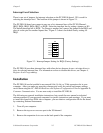
Configuration and Installation Chapter 2
PC-DIO-96 User Manual 2-8 © National Instruments Corporation
I/O Connector Signal Connection Descriptions
Pin Signal Name Description
1, 3, 5, 7, 9, 11, 13,
15
APC<7..0> Bidirectional Data Lines for Port C of PPI A—APC7 is the
MSB, APC0 the LSB.
17, 19, 21, 23, 25,
27, 29, 31
APB<7..0> Bidirectional Data Lines for Port B of PPI A—APB7 is the
MSB, APB0 the LSB.
33, 35, 37, 39, 41,
43, 45, 47
APA<7..0> Bidirectional Data Lines for Port A of PPI A—APA7 is the
MSB, APA0 the LSB.
2, 4, 6, 8, 10, 12,
14, 16
BPC<7..0> Bidirectional Data Lines for Port C of PPI B—BPC7 is the
MSB, BPC0 the LSB.
18, 20, 22, 24, 26,
28, 30, 32
BPB<7..0> Bidirectional Data Lines for Port B of PPI B—BPB7 is the
MSB, BPB0 the LSB.
34, 36, 38, 40, 42,
44, 46, 48
BPA<7..0> Bidirectional Data Lines for Port A of PPI B—BPA7 is the
MSB, BPA0 the LSB.
51, 53, 55, 57, 59,
61, 63, 65
CPC<7..0> Bidirectional Data Lines for Port C of PPI C—CPC7 is the
MSB, CPC0 the LSB.
67, 69, 71, 73, 75,
77, 79, 81
CPB<7..0> Bidirectional Data Lines for Port B of PPI C—CPB7 is the
MSB, CPB0 the LSB.
83, 85, 87, 89, 91,
93, 95, 97
CPA<7..0> Bidirectional Data Lines for Port A of PPI C—CPA7 is the
MSB, CPA0 the LSB.
52, 54, 56, 58, 60,
62, 64, 66
DPC<7..0> Bidirectional Data Lines for Port C of PPI D—DPC7 is the
MSB, DPC0 the LSB.
68, 70, 72, 74, 76,
78, 80, 82
DPB<7..0> Bidirectional Data Lines for Port B of PPI D—DPB7 is the
MSB, DPB0 the LSB.
84, 86, 88, 90, 92,
94, 96, 98
DPA<7..0> Bidirectional Data Lines for Port A of PPI D—DPA7 is the
MSB, DPA0 the LSB.
49, 99 (see note
below)
+5 V +5 Volts—These pins are connected to the computer’s +5 VDC
supply.
50, 100 GND Ground—These pins are connected to the computer’s ground
signal.
Note: Pins 49 and 99 are connected to the +5 V PC power supply via a 1 A fuse. Replacement fuses are
available from Allied Electronics, part number 845-2007, or Littelfuse, part number 251001.
Port C Pin Assignments
The signals assigned to port C depend on the mode in which the 82C55A is programmed. In
mode 0, port C is considered as two 4-bit I/O ports. In modes 1 and 2, port C is used for status
and handshaking signals with zero, two, or three lines available for general-purpose I/O. The
following table summarizes the signal assignments of port C for each programmable mode.
Consult Chapter 4, Register-Level Programming, for programming information.


















